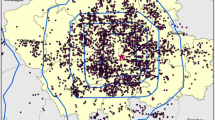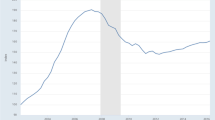Abstract
Housing is central to the broader economy, as highlighted by the Great Recession of 2007–2009, yet few reliable long-run series exist for sale and rental prices of housing. Using hedonic methods, frequency conversion techniques, and a detailed dataset of over one million sale and rental listings from newspapers and online, we construct new indices of sale and rental prices from 1945 for Dublin, Ireland as a whole and for six sub-markets within the city. Sale prices rose by an average of 8.4% per year between 1945 and 2018, compared to an increase in general consumer prices of 5%. Market rents are estimated to have increase by 6.3% per year, well above prior estimates (4.4%), a finding with implications for accurately measuring living costs and living standards in Ireland since World War II. There is some evidence of rents converging across markets within the city but sale prices have diverged over the same period. Adjusting for inflation, there have been four major housing market cycles since 1945, with peaks in the late 1940s, the early 1970s, the early 1980s and the mid-2000s. The presence of both sale and rental information allows the calculation of the ratio of sale to rental prices for housing, the housing price ratio, a fundamental barometer of housing market health. We identify three phases in the gross yield on Irish housing since 1945, with downward shifts in the yield in the early 1970s and mid-1990s. An error-correction econometric analysis confirms the predictions of economic theory, that credit conditions in the credit market and user cost drive changes in the yield over time.









Similar content being viewed by others
Notes
For an overview of existing data series for many countries, including descriptions of their limitations, see Knoll et al. (2017).
To this may be added Deeter et al. (2017), although their series ends in 1949 and for the twentieth century covers properties that had largely switched from residential to commercial usage.
This can be relaxed by including properties with no known size information as a separate category, without affecting the overall results substantively. Unusually large properties (for example, where bedroom number is known to be above six) are treated separately, typically with a coding of 9. Again, these can be excluded without affecting the results substantively.
The same techniques can also applied to the annual city-level analysis to produce indices at quarterly frequency; these results may be useful for those conducting macroeconomic analysis at quarterly frequency and are available from the authors on request.
References
Addison-Smyth, D., McQuinn, K., & O'Reilly, G. (2009). Modelling credit in the Irish mortgage market. Economic and Social Review, 40(4), 371.
Ambrose, B. W., Eichholtz, P., & Lindenthal, T. (2013). House prices and fundamentals: 355 years of evidence. Journal of Money, Credit and Banking, 45(2–3), 477–491.
Ambrose, B. W., Coulson, N. E., & Yoshida, J. (2015). The repeat rent index. Review of Economics and Statistics, 97(5), 939–950.
Bracke, P. (2013). How long do housing cycles last? A duration analysis for 19 OECD countries. Journal of Housing Economics, 22(3), 213–230.
Browne, F., Conefrey, T. & Kennedy, G. (2013). Understanding Irish house price movements – A user cost of capital approach. Research technical paper 04RT13, Central Bank of Ireland.
Campbell, S. D., Davis, M. A., Gallin, J., & Martin, R. F. (2009). What moves housing markets: A variance decomposition of the rent–price ratio. Journal of Urban Economics, 66(2), 90–102.
Chambers, D., Spaenjers, C., & Steiner, E. (2019). The rate of return on real estate: Long-run micro-level evidence. Available at SSRN: https://doi.org/10.2139/ssrn.3407236.
de Haan, J., & Diewert, W. E. (2011). Handbook on residential property price indexes. Luxembourg: Eurostat.
Deeter, K., Quinn, F., & Duffy, D. (2017). Dublin house prices: A history of booms and busts from 1708-1949. Journal of the Statistical and Social Inquiry Society of Ireland, 46, 1–18.
Duca, J. V., Muellbauer, J., & Murphy, A. (2011). House prices and credit constraints: Making sense of the US experience. The Economic Journal, 121(552), 533–551.
Eichholtz, P., Korevaar, M., & Lindenthal, T. (2019). 500 Years of Housing Rents, Quality and Affordability. Available at SSRN: https://doi.org/10.2139/ssrn.3418495.
Eichholtz, P., Korevaar, M., Lindenthal, T., & Tallec, R. (2020). The total return and risk to residential real estate. Available at SSRN: https://doi.org/10.2139/ssrn.3549278.
Eisfeldt, A., & Demers, A. (2015). Total returns to single family rentals. National Bureau of economic research working paper #21804.
Fernandez-Corugedo, E., & Muellbauer, J. (2006). Consumer credit conditions in the United Kingdom. Working paper, available at RePEc.
Gerlach, S., & Stuart, R. (2015). Money, interest rates and prices in Ireland, 1933-2012. Irish Economic and Social History, 42(1), 1–32.
Gerlach, S., Lydon, R., & Stuart, R. (2016). Unemployment and inflation in Ireland: 1926-2012. Cliometrica, 10(3), 345–364.
Gordon, R. J., & Van Goethem, T. (2004). A century of downward Bias in the Most important component of the CPI: The case of rental shelter, 1914-2003. Hard-to-Measure Goods and Services: Essays in Memory of Zvi Griliches, Studies in Income and Wealth, 67.
Harmon, C. & Hogan, V. (2000). Econometric analysis of the housing market and projections of future developments. In: P. Bacon & F. MacCabe, eds, The Housing Market in Ireland: An Economic Evaluation of Trends & Prospects, Government of Ireland Publications.
Himmelberg, C., Mayer, C., & Sinai, T. (2005). Assessing high house prices: Bubbles, fundamentals and misperceptions. Journal of Economic Perspectives, 19(4), 67–92.
IMF (2003). Ireland: 2003 article IV consultation – Staff report; staff supplement; and public information notice on the executive board discussion for Ireland. Country report 03/242, International Monetary Fund.
Johansen, S. (1988). Statistical analysis of cointegration vectors. Journal of Economic Dynamics and Control, 12(2–3), 231–254.
Jordà, Ò., Knoll, K., Kuvshinov, D., Schularick, M., & Taylor, A. M. (2019). The rate of return on everything, 1870–2015. Quarterly Journal of Economics, 134(3), 1225–1298.
Kelly, R., McCann, F., & O'Toole, C. (2018). Credit conditions, macroprudential policy and house prices. Journal of Housing Economics, 41, 153–167.
Kenneally, M. F., & McCarthy, J. V. (1982). A preliminary econometric investigation of the Irish housing market. Economic and Social Review, 14(1), 41–69.
Kennedy, G. & McQuinn, K. (2011). Scenarios for Irish house prices, Economic Letters, 2011:2, Central Bank of Ireland.
Kenny, G. (1999). Modelling the demand and supply sides of the housing market: Evidence from Ireland. Economic Modelling, 16(3), 389–409.
Kholodilin, K. A. (2016). War, housing rents, and free market: Berlin's rental housing during world war I. European Review of Economic History, 20(3), 322–344.
Kholodilin, K. A., Limonov, L. E., & Waltl, S. R. (2019). Housing rent dynamics and rent regulation in St. Petersburg (1880-1917). DIW discussion papers no. 1780.
Knoll, K., Schularick, M., & Steger, T. (2017). No price like home: Global house prices, 1870-2012. American Economic Review, 107(2), 331–353.
Lyons, R. C. (2015). East, west, boom and bust: The spread of house prices and rents in Ireland, 2007–2012. Journal of Property Research, 32(1), 77–101.
Lyons, R. C. (2018). Credit conditions and the housing price ratio: Evidence from Ireland’s boom and bust. Journal of Housing Economics, 42, 84–96.
Lyons, R. C. (2019). Can list prices accurately capture housing price trends? Insights from extreme markets conditions. Finance Research Letters, 30, 228–232.
Malpezzi, S. (2003). ‘Hedonic pricing models: A selective and applied review’. In: Tony O'Sullivan, Kenneth Gibb (eds.), Housing Economics and Public Policy: Essays in honour of Duncan Maclennan (2003), pp. 67-89.
Margo, R. A. (1996). The rental price of housing in New York City, 1830–1860. The Journal of Economic History, 56(3), 605–625.
McQuinn, K. (2004). A model of the Irish housing sector. Research Technical Papers 1/RT/04, Central Bank of Ireland.
McQuinn, K., & O'Reilly, G. (2008). Assessing the role of income and interest rates in determining house prices. Economic Modelling, 25(3), 377–390.
Muellbauer, J. (2007). Housing, credit and consumer expenditure. Proceedings - Economic Policy Symposium - Jackson Hole, Federal Reserve Bank of Kansas City, pp. 267–334.
Murphy, A. (1998). Econometric Modelling of the Irish housing market. In: P. bacon, F. MacCabe & a. Murphy, eds, An Economic Assessment of Recent House Price Developments, Government of Ireland Publications.
Murphy, A. (2005). Modelling Irish house prices: A review and some new results. Oxford: Working Papers, Nuffield College.
Murphy, A. & Brereton, F. (2001). Modeling Irish house prices: A review. Irish Economic Association 2001 Annual Conference.
Offer, A. (2014). Narrow banking, real estate, and financial stability in the UK, c. 1870-2010. British Financial Crises since, 1825, 158–173.
Officer, L. H., & Williamson, S. (2020). The annual consumer price index for the United States, 1774–present. MeasuringWorth. http://www.measuringworth.com/uscpi/. Accessed 27 Aug 2020.
Poterba, J. M. (1984). Tax subsidies to owner-occupied housing: an asset-market approach. Quarterly Journal of Economics, 99(4), 729–752.
Rae, D. & van den Noord, P. (2006). ‘Ireland's housing boom: What has driven it and have prices overshot?’, OECD Economics Department Working Papers.
Roche, M. (2004). Will there be a crash in Irish house prices? Quarterly Economic Commentary, 2003(4), 1–16.
Shiller, R. J. (2005). Irrational exuberance. Princeton: Princeton University Press.
Shimizu, C., Nishimura, K. G., & Watanabe, T. (2012). ‘House prices from magazines, realtors, and the Land Registry’. In: Bank for International Settlements (ed.), Property markets and financial stability (2012), pp. 29-38.
Silver, M. S. (2016). How to better measure hedonic residential property price indexes. International Monetary Fund.
Stevenson, S. (2003). Economic, demographic & fiscal influences on housing market dynamics, UCD Centre for real estate research working paper Series, University College Dublin School of Economics.
Stevenson, S. (2008). Modeling housing market fundamentals: Empirical evidence of extreme market conditions. Real Estate Economics, 36(1), 1–29.
Stuart, R. (2017). ‘70 years of personal disposable income and consumption in Ireland’. Journal of the Statistical and Social Inquiry Society of Ireland, XLVI, 47–70.
Thom, D. R. (1983). House prices, inflation and the mortgage market. Economic and Social Review, 15(1), 57–68.
Acknowledgements
We would like to thank the reviewers and the editor for very helpful feedback that greatly improved the text and Finn McLaughlin and Sean Moran for their excellent research assistance. We would also like to thank the following for their valuable contributions in building the dataset used here: Kerri Agnew, Garrett Doocey, Patrick Ferguson, Silvia Gallagher, Samuel Logan, Sean McKiernan, Niall Murphy, and Andrew Salter.
Author information
Authors and Affiliations
Corresponding author
Additional information
Publisher’s Note
Springer Nature remains neutral with regard to jurisdictional claims in published maps and institutional affiliations.
Appendices
Appendix 1
Appendix 2
Appendix 3
Rights and permissions
About this article
Cite this article
Keely, R., Lyons, R.C. Housing Prices, Yields and Credit Conditions in Dublin since 1945. J Real Estate Finan Econ 64, 404–439 (2022). https://doi.org/10.1007/s11146-020-09788-z
Published:
Issue Date:
DOI: https://doi.org/10.1007/s11146-020-09788-z




